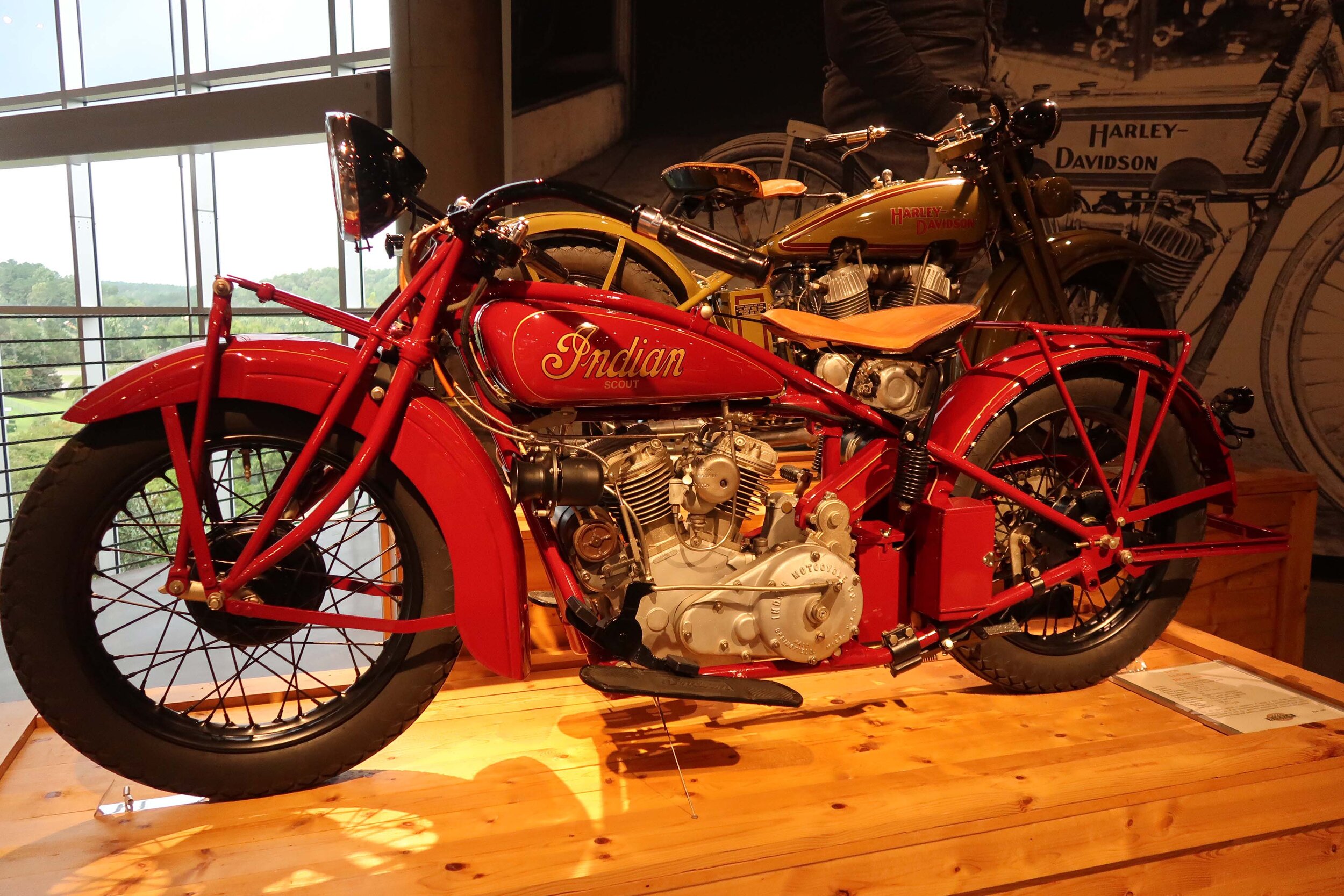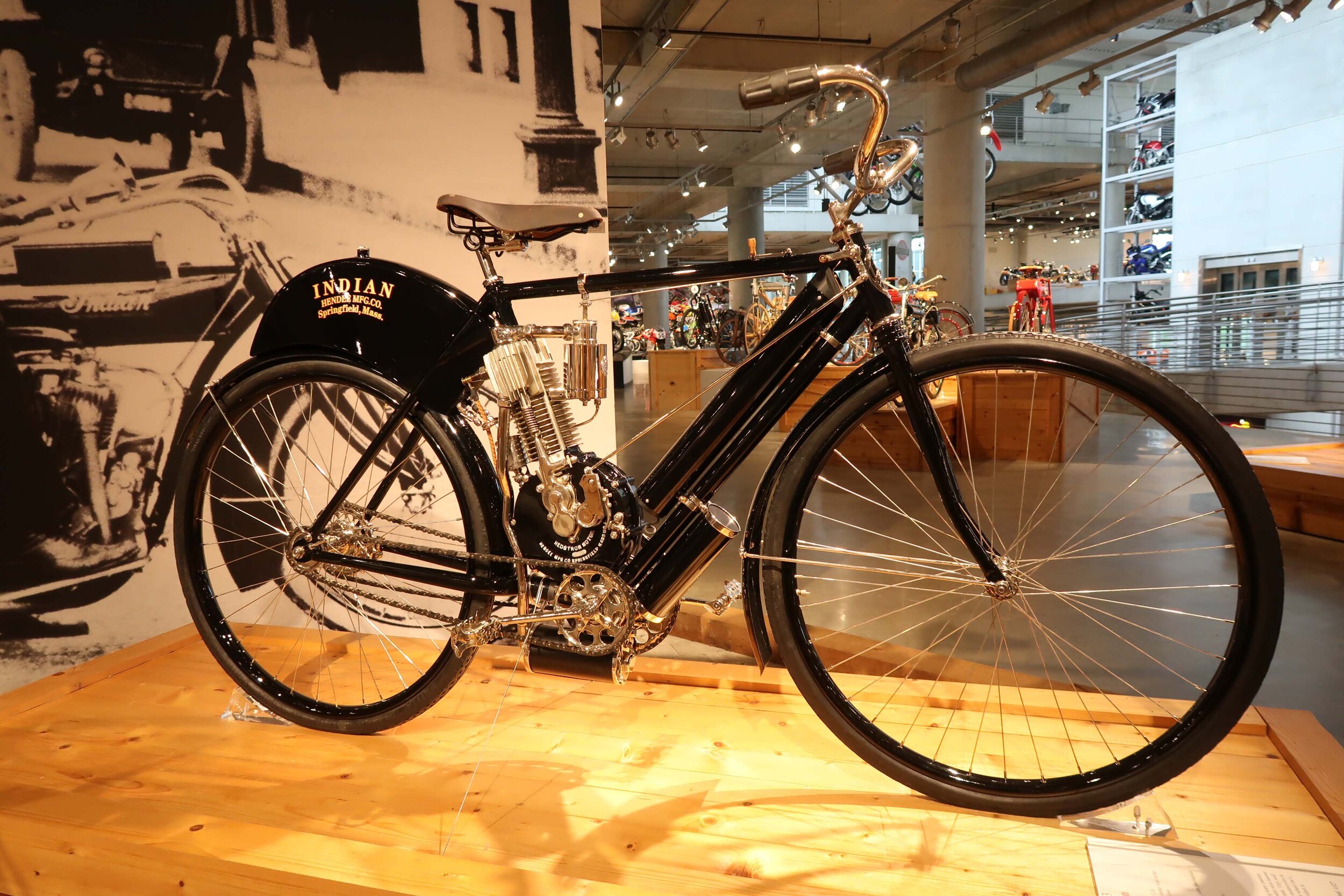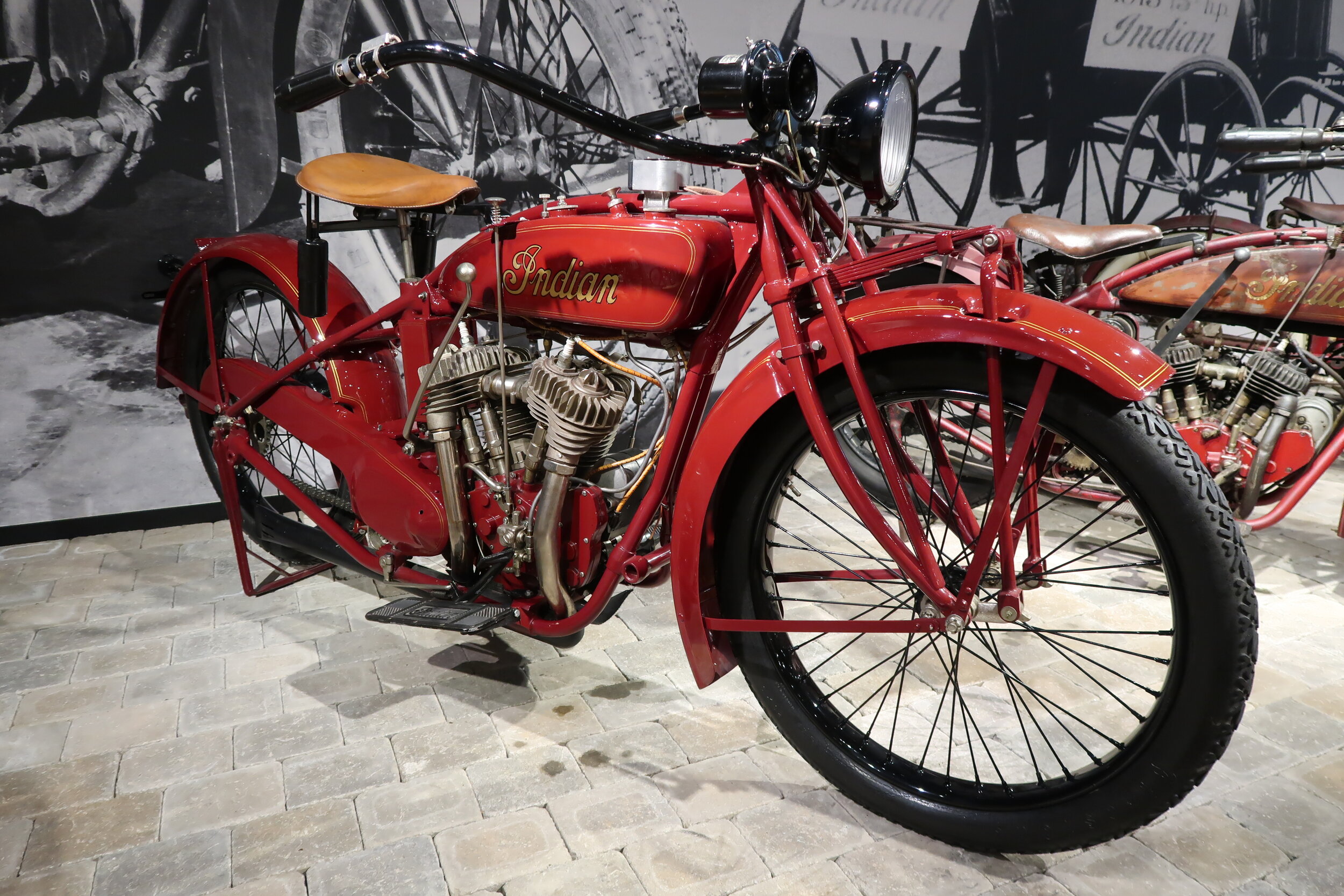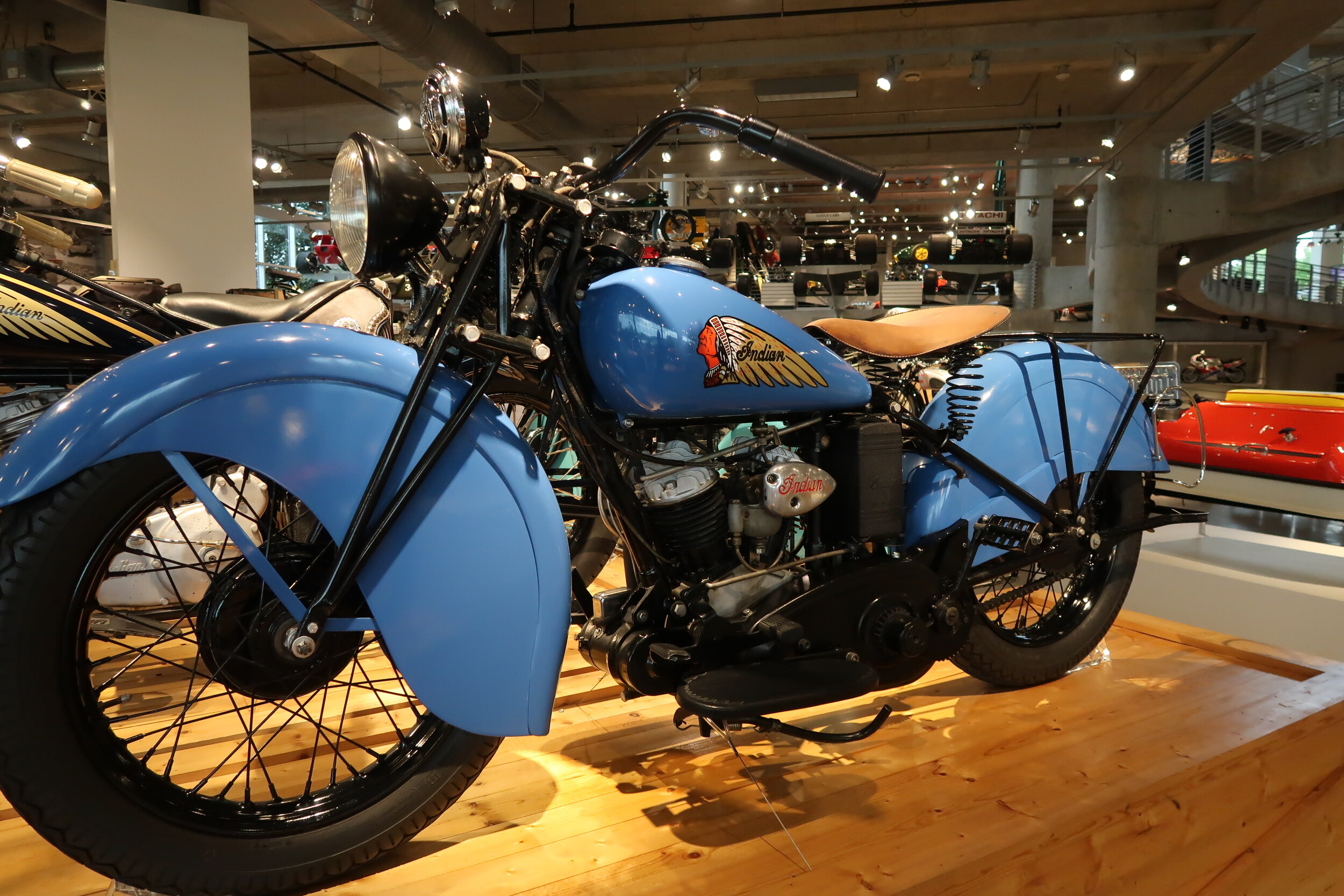These shots were taken at the Barber Motorcross Museum in Birmingham, Alabama. It is truly a remarkable museum even if you are not a motorcycle owner or fan. There are over 900 vehicles in this museum—every one of which is functional. If you are in the Birmingham area and want to spend a few hours looking at some remarkable machines then I highly recommend you visit the Barber Museum.


The “F” head Indian, designed by Oscar Hedstrom, was one of the better designs. Reliability, quality and good performance made these machines very much sought after. At the time, Indian was the largest producer of motorcycles in the world, building over 20,000 machines in 1913, and by 1923 they had reached the milestone of a quarter of a million machines.






Inspired by the British-built Douglas and built to compete with it in overseas markets where light, fuel efficient motorcycles were popular, this Indian “O” model was not a sales success, being expensive and slow. Produced for only two years, 1917 and 1918, this machine is extremely rare. This one had the original Massachusetts 1917 license plate

A lesser known Indian, it was made for one year only. This 13.5 ci Model K Featherweight is a rare example of an early American motorcycle. A low cost ($150) utility motorcycle, the Featherweight is powered by a single cylinder, two-stroke engine driving the three-speed transmission and chain final drive. Unfortunately for Indian, the Featherweight turned out to be a marketing disaster and was replaced in 1917 by a new lightweight model—Model O—powered by a four stroke, horizontally-opposed twin cylinder engine inspired by the British Douglas

In 1928 the Indian Ace was replaced by the Indian 401, designed by Arthur O. Lemon, former Chief Engineer at Ace, who was employed by Indian when they bought Ace. The Ace’s leading-link forks and quarter-coil springs were replaced by Iddian’s trailing-link forks and quarter-elliptic leaf spring. The 1,265cc engine had overhead inlet valves and side exhaust valves and delivered about 30 horsepower. The Indian Four of 1928-31 shared most of its parts with the 101 Scout. It’s a low built, pleasantly streamlined machine with the added attraction of a smooth power source. With less that 2000 made, the 401 is a favorite for many collectors.

The 101 Scout gained a reputation of being a very tough, capable motorcycle. One of its outstanding features was its steering stability. The Indian Scout is still the preferred machine for carnival trick riding. Engineering design and quality is outstanding for a 90 year old machine.

Indian was a leader in early motorcycle design, registering many patents on components that are still used today. The pre-teens models were known as “camelbacks”, due to the shape and location of the gas tank. Very well constructed, these early model Indians were really the first motorcycles to be mass produced in large numbers. This model has wooden wheel rims and has a very low serial number indicating it as one of the oldest in existence.

To capitalize on their Isle of Man Victory in the Tourist Trophy races where they finished first and second, Indian released competition models in both single and twin versions with all chain drive and two-speed transmissions. These T.T. models had a great advantage over the European bikes that were single speed, belt driven designs.

Indian astonished the motorcycle community in 1914 when they introduced the Hendee Special that featured an electric starter, along with electric lights and horn. Unfortunately, battery technology was in its infancy and problems with the starting and charging forced Indian to remove the electrical equipment and revert to a conventional system. There are only a handful of these models known to exist today, and it would be another 40 years before electric starters became standard equipment on motorcycles. The starter on this original unrestored Indian is fully operational.

Indians big selling point in 1914 was the availability of electric lighting and horn on certain models. This was a great improvement over the troublesome carbine lamps of the period. No generator was used; power for the lights came from two batteries carried in wooden boxes located below the saddle. The boxes are missing from this original and unrestored example. Indian advertised that they would build 3,000 machines a day with a total annual output of 60,000 for 1914.

This incredibly reliable machine was advertised with the slogan, “You can’t wear out an Indian Scout.” One of these machines set a 24-hour record in 1920, covering 1,114 miles! The low build and stability of the Scout made it very popular for stunt riding with a few machines still in use today in carnivals. This example is original and unrestored, and will remain in this condition.

Introduced in 1920, the 37 cu. in. Scout was a brilliant new design that resulted in record sales for Indian. To capitalize on this sales success, a large capacity model was released in 1922, the 61 cu. in Chief. To compete with the Harley Davidson big twins the 73 cu. in. Big Chief was announced the following year. With a new frame complete with sidecar attachment lugs, Indian finally had a versatile touring model that could compete with anything on the market.

These single cylinder race bikes were the forerunners of the current speedway and dirt track machines. Running on alcohol they could attain speeds approaching 90 m.p.h. This is an extremely rare model with short cast aluminum dual port exhaust headers and twin carburetors. It is thought that fewer than four of these bikes are known to exist today.



To publicize their new ‘08 twin cylinder machines, Indian build a small number of stripped down models to compete at board track races. The motors were bored out from 38 cu. in. to 61 cu. inches, resulting in a 7 horsepower output. In the hands of hired professional riders, these Indians were fast and reliable. The rear mounted saddle enabled the rider to crouch over the machine to reduce wind resistance. Spectators nicknamed riders of these machines “Monkey on a Stick.”

Indian racers dominated the board tracks for years, unchallenged by other marques. The factory would build a few special racing machines for their top riders, such as this one, which features four valves per cylinder. There is no throttle control on the pre-set, wide-open Hendee carburetor. Speed was controlled by a magneto kill button on the handlebars.

The 80-inch Chief was the final fling of the ailing Indian Company. The machines were becoming outdated, losing sales to Harley Davidson and the imports. Production ended in 1953, after more than 50 years of being the pioneer in early motorcycle production and development.

Originally presented to NASCAR champion Jeff Gordon, this custom built Indian was purchased by the museum at an auction to benefit the Hendrick Marrow and Make-A-Wish foundations. The motor is by S&S, an aftermarket supplier, as Indian was still developing their own power unit at this time. The custom paint and machined billet aluminum accessories are unique to this machine.


American entrepreneur Floyd Clymer set out to update the venerable Velocette with Italian chassis components. The duplex frame was built by Tatarini in Bologna, Italy, using Marzocchi suspension components and Grimecc (can’t read two words due to flash spot) and overall weight was 45 lbs. less than a stock Venom. Sadly, Clymer died before the project really got going and that was the end of the Veloccette and Indian, Since then, the Indian name has been displayed on a variety of machines.


Floyd Clymer, old time Indian rider turned publisher, owned the Indian name and was looking to put it on a motorcycle. The British Velocette power unit was available, so he took it to Italy where Tartarini built a modern chassis for it, and the Clymer Indian was born. The majority of the machines used the highly tuned Venom motor, this model is one of the 51 built wi a Turuxton high performance motor.

One could say that the Indian fours were the Cadillac of motorcycles as they were smooth and flexible, equally at home trickling through traffic or cruising down the highway. At 77 cu. in. they were one of the largest capacity motorcycles on the market. These features made them very popular with law enforcement agencies.

The open fender, rigid-frame Chiefs are rarer than the later full-skirted fender models. These rigid frame Chiefs had superior acceleration than the later models, where relatively lightweight and larger capacity motors are a good combination.

The Junior Scout was introduced in 1940, complete with the controversial fender skirts, the only year they were fitted to this model. Within two short years the Junior Scout was in military drab paint, as the U.S. Army required a motorcycle to escort convoys, and the little Indian was found to be ideal. Converted to military specification, it was now the Model 741.

Indian’s answer to the British on/off road enduro type machines was this modified Warrior, equipped with all the styling features to make it attractive. Unfortunately, it was not reliable or competitive, and contributed to Indian’s demise. In the 1950’s the Indian company imported British machines and sold them under their own label.

In an attempt to compete with the British imports, Indian embarked on an ambitious and expensive program to design and produce a line of entirely new models. The Warriors were parallel twins of 500cc capacity, and the Arrows 250cc singles, half of the twin. Hastily rushed into production before the bugs were sorted out, they were a disaster and eventually crippled the company.

IN an attempt to boost sales, Indian designed this ski bolt-on conversion that would allow you to operate the machine in the winter season. The “optional” rear tractor tire was a necessity if you wanted forward motion. It is not known how many of these kits were sold or how successful they were.





